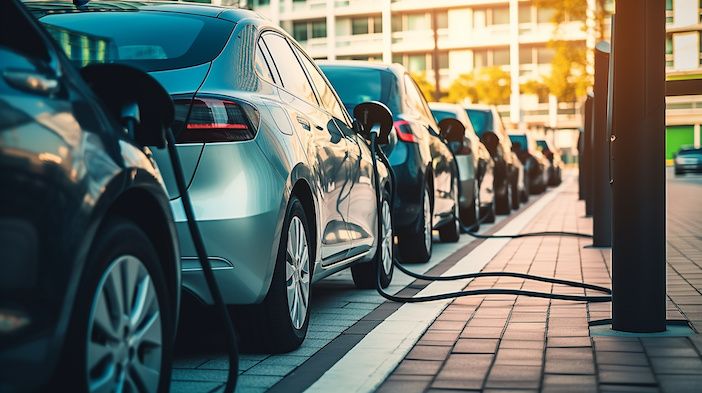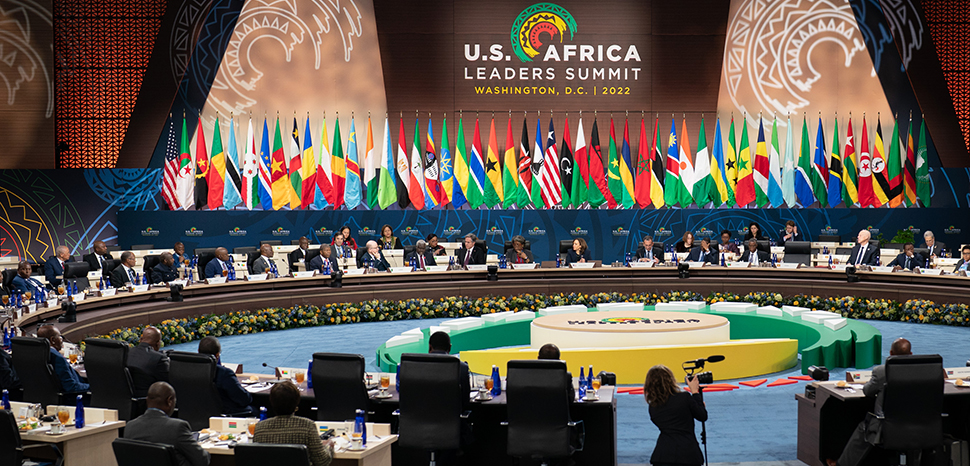Impact of infrastructure investor mega-merger | Upgrading America's EV chargers | Tightening the Belt and Road in Africa

infrastruttura
no. 44
The private asset management firm BlackRock is acquiring the world's biggest independent infrastructure investor in a $12.5 billion deal.
NYC-based Global Infrastructure Partners owns and manages over $100 billion in energy, transportation, digital, and water market sector assets, ranging from toll roads, the Port of Elizabeth (NJ), and data centers to wastewater utilities, airports in the UK and Australia, and even solar installations that power Walmarts. If it passes US regulatory muster the transaction would close later this year and create a $150 billion infrastructure investment platform to "mobilize long-term private capital through long-standing firm relationships," according to GIP founder/CEO Adebayo Ogunlesi, who also chairs President Biden’s National Infrastructure Advisory Council.
Geopolitics are driving increased global demand for trillions of dollars in new logistics, digital infrastructure, and decarbonization infrastructure. And in turn these asset classes are attracting increased attention from a broader swath of investors, priming the pump for a transaction of this magnitude. Coupled with BlackRock's existing $50 billion in infrastructure assets under management, the new combined entity should be large enough to command higher fees from larger institutional investors, including pensions, endowments, and sovereign wealth funds.
GIP is heavily focused on investments in the energy security space, where so much of the capital sloshing around the private infrastructure markets is likely to wind up (McKinsey says $15 trillion is needed by 2030 for the world to meet its climate commitments). For example, last July GIP acquired a 40% stake in TC Energy's Columbia Gas Transmission System, agreeing to spend over $1.2 billion in maintenance and capacity upgrades over the next three years. It has invested in some of the New York offshore wind projects, carbon capture technology, and wind farms through its 40 percent stake in Terra-Gen Power, which owns 23 of them across the West and New York State.
Recently, GIP also invested nearly $6 billion in the Freeport LNG terminal in Texas (where Bechtel is installing electric-powered natural gas liquification trains under a $12 billion turnkey EPC contract. Compared to gas turbine-powered LNG trains these should reduce this particular plant's overall carbon emissions by nearly 90%).
The Biden administration's focus on infrastructure and climate investments through IIJA, IRA, and CHIPS are also creating strong tailwinds for private investment in infrastructure (even as the P3 market in North America, outside of social infrastructure, remains muted). For example, in the last year, Brookfield invested $15 billion in Intel's $30 billion semiconductor manufacturing facility in Arizona, Digital Realty sank $5.3 billion into data centers, and Goldman Sachs Infrastructure Partners spent $4.2 billion to acquire Chicago's Rockford International Airport.
Why are investors so excited about infrastructure?
From both micro and macro perspectives it is not surprising that investors continue to find infrastructure attractive as an asset class. In fact, BlackRock's chairman Larry Fink told investors on a recent earnings call that the firm views infrastructure assets as one of the world's "most exciting long-term investment opportunities," given that both digital and physical infrastructure will continue to evolve and expand as dirigiste governments everywhere "prioritize self-sufficiency and security." These words seem prescient given the dangers looming across the globe as the first month of 2024 comes to a close.
Infrastructure provides private investors with stable cash flows (i.e. from a toll road, or user fees, or utility charges) and can help hedge portfolios against inflation risk (because many cash flows are indexed to inflation). Returns are also less "correlated," in the sense that they can remain positive in the face of negative macroeconomic headwinds. This is because infrastructure in most cases provides an essential service, a fixed asset supply operates under long-term contracts with limited competition, and the cost of developing those assets requires a long-term investment horizon.
Are there any consequences from increased private investment in public assets?
It's true that private infrastructure can foster innovation when companies offload the development of assets that are not core to their business (think Walmart partnering with GIP to develop those solar power systems). And more capital can translate into increased project opportunities and the potential for larger and more complex projects that benefit more people and geographies. This can create new processes and technologies, which could also help the industry shake off its fusty reputation and deliver the necessary improvements to productivity that future investors will demand. But there are potential downsides to the consolidation of investment platforms, which the BlackRock/GIP deal could wind up exacerbating.
First, increasing private investment in public assets will inevitably wrench control over those assets away from the public and into private hands, translating into less control and accountability for taxpayers and the primary users of those assets. By the same token, taxpayers will have less say over where private funds are deployed, which could increase inequality and have uneven social and environmental impacts for communities with different demographic characteristics.
Finally, from the AEC industry's perspective in the trenches, more funding for projects could both increase competition and pressure firms' already thin margins. This same pressure could also accelerate the trend of offshoring design and investor demands to leverage AI and other generative design technologies that may not be quite ready for prime time. Ultimately it could create a flywheel effect of lower quality, safety, and performance standards that ultimately delivers poorly performing assets.
But that's a worst-case scenario. Increased funding for more projects that can help meet the geopolitical moment, fight climate change, and ease the energy transition away from fossil fuels should be cheered.

Infraquote of the week.
The history of Venice is a 2,000 year history of adaptation, in which the solutions were found by trial and error. I am optimistic because there will be great transformation in the future.
Giovanni Cecconi, one of the engineers who designed Venice's MOSE flood prevention system, on how new technologies and approaches could prevent La Serenissima from slipping away permanently under the rising tides of the Adriatic.

The Biden administration is about to dole out $150 million to 24 grant recipients in 20 states who will physically upgrade the reliability of EV charging infrastructure.
The funds will repair or replace around 4500 existing EV charging ports, and come from the National Electric Vehicle Infrastructure (NEVI) Formula Program, a new $5 billion funding mechanism created by IIJA.
The Federal Highway Administration (FHWA) is administering NEVI in order to help states build out an EV charging network that the Biden administration hopes will offer more than 500,000 public EV chargers by 2030. The administration continues to promote the 70% increase in publicly available EV charging ports since President Biden's inauguration and a quadrupling of EV sales in the US during that same time period as evidence of the strides America is making towards a full-blown EV transition.
Unfortunately EVs have been in the headlines lately for less auspicious reasons as sales stalled unexpectedly during the final quarter of 2023. But some recent federal EV initiatives should help the fledgling industry regain momentum. These include $600 million in funding for 47 EV charging projects in 22 states under the Charging and Fueling Infrastructure (CFI) Discretionary Grant Program, awarded at the very start of 2024, and Ohio and New York opening the country's first fast EV charging stations funded through the NEVI Formula Program mentioned above (although it appears at least in the Empire State some kinks still need to be worked out).


Infrastat of the week.
$1.6 billion: Loan proceeds that New York-based Plug Power expects to receive from the US Department of Energy to construct six green hydrogen production plants across the country that, when completed in 2025, would produce 500 tons per day.

China's Belt and Road Initiative is struggling in Africa, creating an opening for the US to leverage its geopolitical heft against the influence of Beijing.
In a "shot across the bow" of the CCP the US plans to lend $250 million to the Angolan government in order to challenge China's influence and presence in southern Africa, spurring the development of a critical, $1.7 billion, green-energy metal freight rail corridor that would carry millions of tons of copper and cobalt out of the Congo, to Angola's Atlantic coast.
In 2022, Angola turned down a Chinese bid to operate the line (known as the Lobito Corridor) and instead granted a 30-year concession to a European consortium (backed by the US). This is important because Angola has, historically, been Africa's largest recipient of Beijing-backed Belt and Road Initiative infrastructure development loans.
America's machinations in Africa are focused on other geopolitical priorities besides China. For example, Russia's Wagner mercenary group has for years backed numerous anti-Western militant groups, creating chaos for governments across the continent. In response, the Biden administration has pushed the U.S. Export-Import Bank to backstop loans for solar energy projects, pre-fabricated bridges, and other rail projects in Africa that could strengthen economies, governments, and other civil institutions that have historically fallen victim to post-colonial foreign interference and exploitation.


Around the industry.
- Chicago's transit system is asking the State of Illinois for help with budget cuts. (Axios)
- Meanwhile, in the Garden State, New Jersey Transit is planning to raise fares by 15 percent this summer, with more increases to follow in subsequent years. (Politico)
- Why a "new approach" is necessary for the UK to deliver mega-projects in the aftermath of HS2 and Brexit. (P3 Bulletin)
- Urbanists everywhere should rue the demise of micromobility companies, even if e-scooters aren't your preferred means of public transportation. (Fast Company)
- Fusion: will it remain America's "power of the future" indefinitely, or are there reasons to be optimistic about its near-term commercial viability? (Space.com)





Member discussion